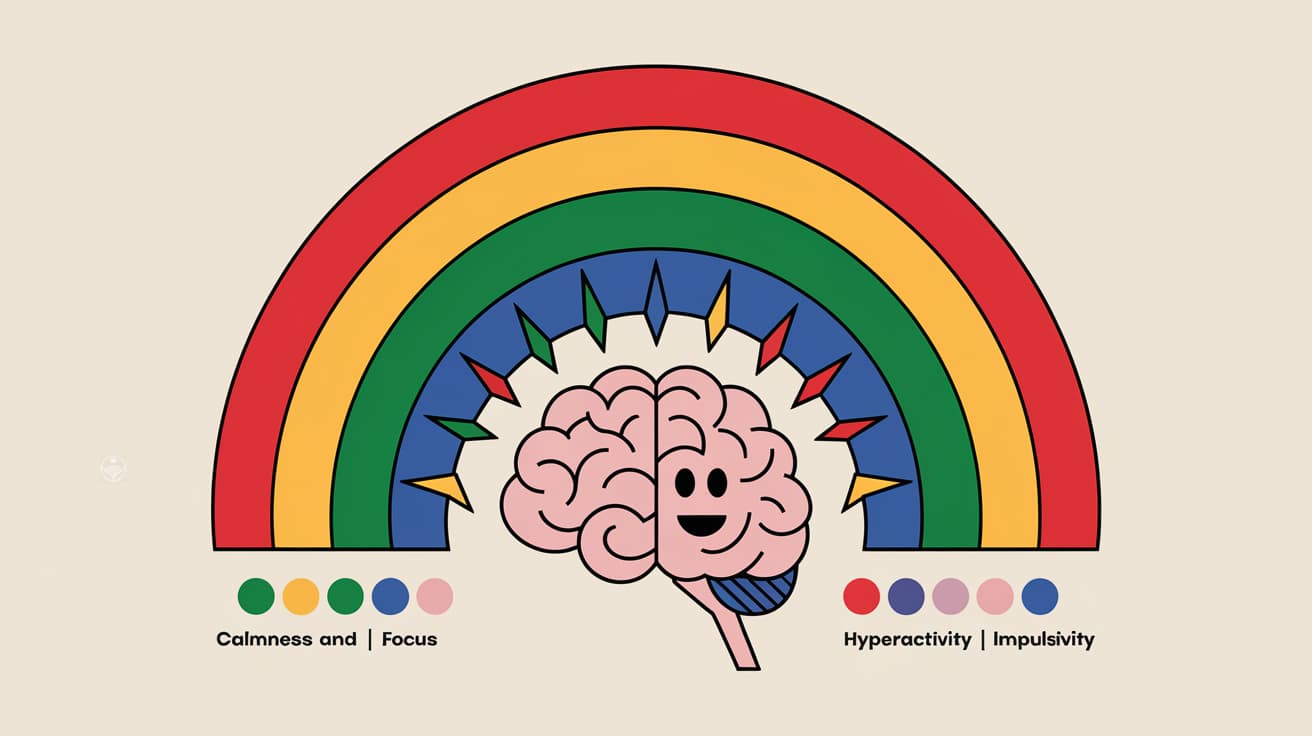The Rainbow Problem: Effects of Food Colourings on ADHD and Neurodivergent Brains.
Picture this: a kid sipping a fluorescent blue slushie, vibrating with energy, while their parent looks like they’ve aged ten years in ten minutes. Coincidence? Probably not. The effects of food colourings on ADHD (and other neurodivergent brains) are a hot topic for good reason. These additives aren’t just fun for the eyes; they’re often chaos in a packet, stirring up hyperactivity, impulsivity, and irritability.
And before you neurotypical folks grab your popcorn, you’re not immune either. That dopamine hit from your neon-pink cupcake? It’s messing with you too. Let’s dive into the science, break down the colourful chaos, and explore what to avoid (and what to embrace) for a calmer, happier brain.
What Are the Effects of Food Colourings on ADHD?
Artificial food colourings (AFCs) are synthetic dyes that make your snacks and drinks look like they’ve just stepped out of a cartoon. Made from petroleum (yep, the same stuff that fuels cars), they’re found in everything from sweets to cereals. But the effects of food colourings on ADHD go beyond a sugar rush, because they can exacerbate core symptoms like hyperactivity and inattention.
Unlock peak brain performance with science-backed biohacks. Join free now & get your guide for just £4.99 (45% off)!

ADHD and Artificial Food Colourings
Studies show a clear link between AFCs and worsened symptoms of ADHD, especially in children. For some, consuming Red 40 or Yellow 5 can feel like adding petrol to a campfire. Behavioural issues, hyperactivity, and emotional dysregulation are common reactions, making these additives a no-go for many families managing ADHD.
Autism and Food Sensitivities
The effects of food colourings on ADHD often overlap with Autism Spectrum Disorder (ASD). While research is still catching up, anecdotal evidence suggests these additives may heighten sensory sensitivities or exacerbate behavioural challenges. This could be tied to disruptions in the gut-brain axis, which is a fascinating (and slightly gross) connection that’s gaining traction in neuroscience.
Neurotypicals Aren’t Off the Hook
Oh yes, even neurotypical brains can feel the pinch. Research has shown that AFCs can lead to increased hyperactivity and irritability in children without ADHD. Turns out, no one’s brain is a fan of being duped by synthetic colours.
Dopamine: The Junk Food Whisperer
Why are we so drawn to the very foods that wreak havoc? Blame dopamine—the brain’s “pleasure chemical.” Foods high in sugar and packed with colourings are dopamine goldmines, offering a temporary high that’s hard to resist.
For neurodivergent individuals, particularly those with ADHD, the brain’s dopamine system often operates at a deficit. This makes the lure of colourful, sugary snacks even stronger. But here’s the kicker: that dopamine boost is short-lived, and the crash that follows can leave you feeling worse than before.
What to Avoid: Foods and Additives to Watch
If you’re looking to limit the effects of food colourings on ADHD (and general well-being), here’s what to avoid:
- Artificial Food Colourings: Red 40, Yellow 5, Blue 1—basically anything that looks like it belongs in an art supply shop.
- Preservatives: Sodium benzoate has been linked to hyperactivity in some children, making it a common additive to avoid.
- High-Sugar Foods: They deliver a dopamine spike but leave you crashing faster than a toddler post-cupcake.
- Ultra-Processed Foods: These often combine colourings, preservatives, and other nasties for a triple threat to your brain health.
The Fix: Foods That Support the Brain
Instead of synthetic colours, go for nature’s rainbow. Real, vibrant foods not only look stunning but also nourish your brain without the chaos.
- Fruits and Veggies: Blueberries, spinach, carrots, and red peppers bring natural colours and a nutrient boost.
- Omega-3 Fatty Acids: Salmon, walnuts, and flaxseeds support brain function and emotional regulation (we’ve written about Omega-3‘s a LOT!).
- Whole Grains: Brown rice, oats, and quinoa offer steady energy without the spikes.
- Lean Proteins: Eggs, chicken, tofu, or lentils keep your neurotransmitters happy.
- Dark Chocolate: A healthy treat that boosts mood and focus—just don’t overdo it! (We’re not saying you can devour a whole bar, but we’ll explain why chocolate gets a green light in the next section.)
Let’s Talk About Chocolate
We know what you’re thinking: “Chocolate? Really?” Yes, really. Dark chocolate earns its place in the spotlight for a few solid reasons… but… before you raid the snack drawer, let’s break it down.
Why Dark Chocolate?
It’s all about the cocoa. Dark chocolate (70% or higher) is packed with flavonoids, natural compounds that improve brain function, reduce stress, and even boost focus. It’s also a natural source of magnesium, which helps with emotional regulation, which is something many neurodivergent folks can benefit from.
How Much Chocolate?
Moderation is the magic word. Aim for about 20-30 grams a day (roughly 1-2 squares). That’s enough to get the benefits without the sugar crash (or the guilt).
What to Avoid
Not all chocolate is created equal. To get the good stuff, steer clear of:
- Milk Chocolate: Too much sugar, too little cocoa.
- White Chocolate: Delicious? Sure. But it’s just cocoa butter and sugar.
- “Dark” Chocolate Below 70% Cocoa: More marketing than magic, you should probably check those labels.
Why We’re Letting You Have Chocolate
Because life isn’t all kale and quinoa. A little bit of dark chocolate can be part of a balanced, brain-boosting diet. It’s a small treat that makes a big difference for mood and focus—when enjoyed responsibly.
So yes, you have our blessing to indulge in a few squares of the good stuff. Just remember, we said squares, not slabs.
Countering the Effects of Food Colourings on ADHD
If artificial food colourings have already made their way into your diet, here are some tips to minimise the damage:
- Stay Hydrated: Water helps flush out toxins and reduces cravings.
- Snack Smarter: Replace colourful sweets with nutrient-rich options like nuts or dried fruit.
- Exercise: Physical activity naturally increases dopamine, reducing the temptation for junk food.
- Eat Regularly: Balanced meals stabilise blood sugar and prevent those “hangry” moments.
- Supplement Wisely: Omega-3s and magnesium are great allies for brain health.
Where Does This Fit on Herbal Biohacker?
This blog complements our existing content, like 6 Healthy Foods for Children With ADHD and our deep dive into preservatives. By linking these posts, we create a cohesive guide for anyone looking to support ADHD and neurodivergent health through diet. Plus, it’s another step towards making Herbal Biohacker the go-to resource for natural neurodivergent living.
The Takeaway: Real Rainbows Only
When it comes to your brain (and your kids’), skip the synthetic rainbows and embrace the real deal. Colourful fruits, veggies, and whole foods aren’t just good for you, but they’re delicious. Choose wisely, and you’ll be doing your brain a favour.
Join Us!
Join our community for more tips, tricks, and laughs on living your best neurodivergent (or neurotypical) life. Bonus points if you bring dark chocolate.







